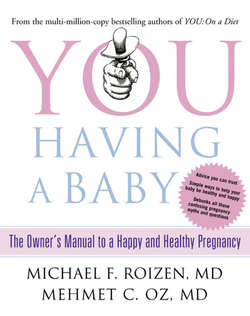Читать книгу You: Having a Baby: The Owner’s Manual to a Happy and Healthy Pregnancy - Michael Roizen F. - Страница 37
The Point of the Placenta:
Formation and Function
ОглавлениеUnless you’re starring in Alien, the general rule about organ development is that all of your organs are formed in utero, and that’s the set you live with. There aren’t too many instances of new organs or organlike substances appearing on a whim (unless you count fat, tumors, and the regenerative liver). But there is one big exception: the placenta. As we explain below, you can think of it as a kind of an organ transplant from your fetus to you that forms naturally inside you.*
Here’s how the magic works. After conception, the fertilized egg (now called the blastocyst) meanders to the end of your Fallopian tube and enters your uterus, searching for the uterine wall. As we stated in the previous chapter, this trip is the most dangerous trip any human being ever takes, because if the blastocyst does not implant successfully within seven days of conception, the uterine lining will be shed, and you’ll never even know you were pregnant. If it does, the placenta will begin to form at the point of attachment. Generally, the placenta starts to develop about a week after conception. If you take a look at figure 2.1, you’ll see that the blastocyst is made up of two layers: an inner cell mass and an outer layer. The inner cell mass is what becomes the embryo; the outer layer is what forms the fetal side of the placenta.
When the blastocyst implants in the uterine wall, the cells from that outer layer begin to form what are called chorionic villi. These villi, which look like coral reefs, carry blood vessels that go from the placenta into the spongy uterine wall, and it’s through the walls of those blood vessels that nutrients and waste are exchanged. A pool of maternal blood, called a blood lake, surrounds the villi. Your blood pressure forces blood through this lake and around the villi so they can absorb and pass needed nutrients and antibodies for immunity to your baby, and transfer the baby’s waste products to your circulatory system for disposal. During this process, there is no direct blood-to-blood contact between mother and child. About the same time that the placenta is forming, your hormones stimulate the inside layer of your uterus—already rich with blood vessels—to grow those vessels larger to facilitate the exchange.
Figure 2.1 Natural Resource Shortly after conception, the cells of the blastocyst need to find a way to absorb mom’s nutrients. So the outer layer of cells forms part of the placenta, while the inner layer forms the foundation of the fetus itself.
Factoid: The fetus needs to have oxygen continually. Its placenta supplies enough for one to two minutes, so a fetus can essentially hold its breath for that long. When a woman is in labor and having contractions, the amount of blood in the placenta lake decreases. As contractions get longer, the baby’s heart rate decelerates, providing a way to gauge fetal oxygen levels during delivery.
Factoid: Despite the small size of the placenta, the surface area of the villi is remarkably large. With about 700,000 villi, the surface area available for exchange is approximately the size of a one-bedroom house.
Once the placenta is fully formed and attached to the uterine wall (about the end of the first trimester), you can see a distinct difference between the maternal territory and the fetal territory. The maternal side is red and bumpy, from the shape of the villi poking through, while the fetal side is like a skating rink: smooth and slick, with the umbilical cord projecting from the surface.
But to think that the placenta is a one-trick pregnancy pony would be a mistake. Besides filtering and exchanging nutrients and gases, it has other duties, including making and secreting many hormones. Some of these include:
Estrogen: In pregnancy, estrogen stimulates the growth of the uterus and improves blood flow between the uterus and placenta. It also preps the breasts for milk production by enlarging a woman’s milk ducts. Estrogen secretion peaks right before birth.
